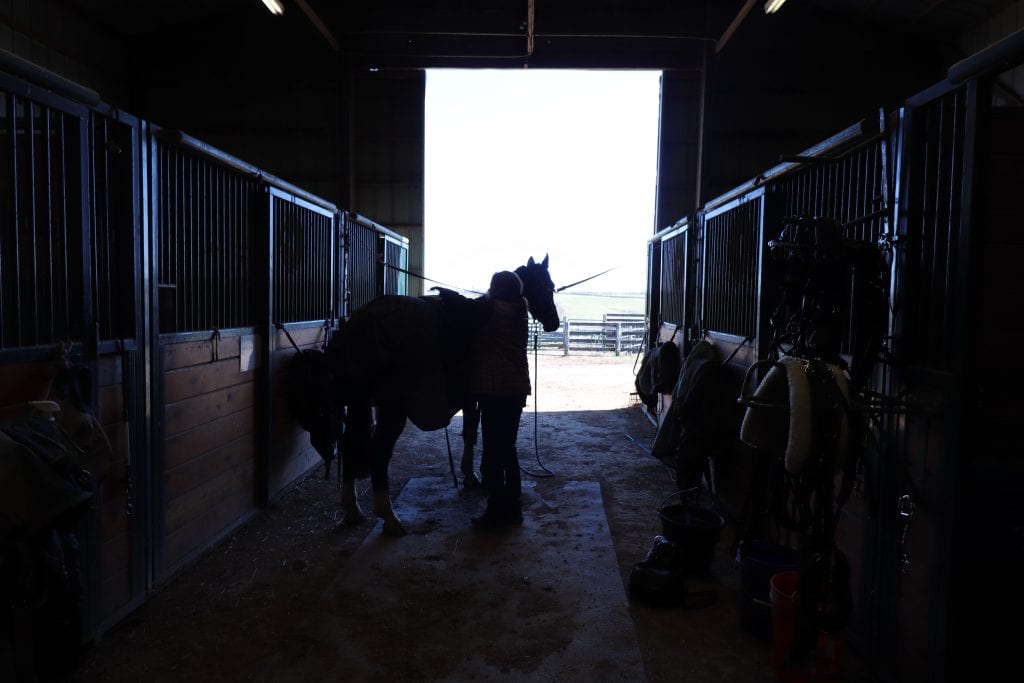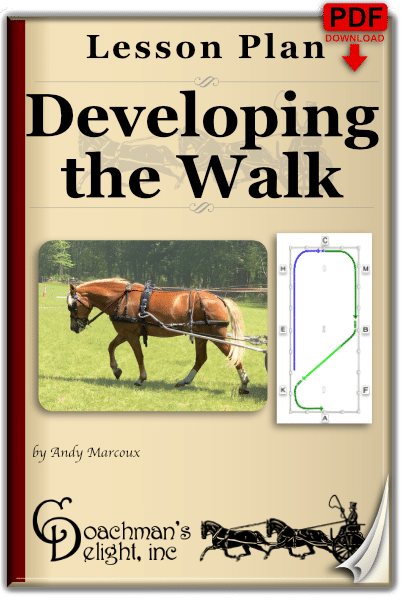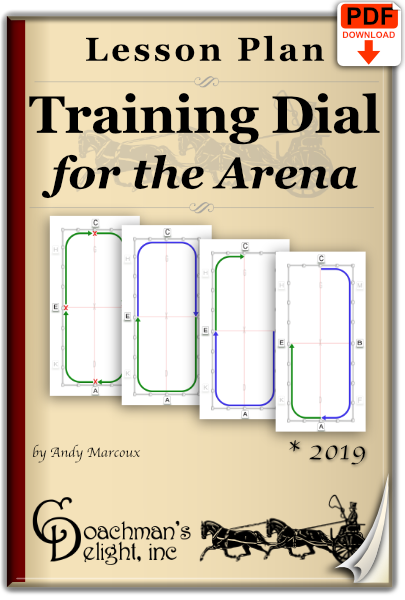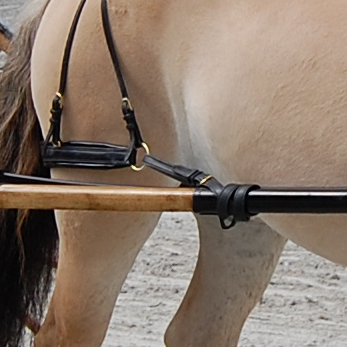I’ve had quite a few people asking me about getting horses going again after their long winter off. The question always is: How to get the horse back in shape without over-doing it, but fit that work into the already demanding schedules that humans have to keep?
Start with the rule in mind: “less is more.” Gradual improvements over many sessions will create lasting results. If you try to hurry up and get everything done all at once, you’re setting yourself up for setbacks. Those can come in the form of temperamental issues, or physical break-downs.
The timelines suggested in these exercises assume that you have the opportunity to work with your horse 3-4 days per week. If you are only able to work with your horse 1 or 2 days a week, it’s okay. It just will take a few more weeks to move through the various stages of work.
Work with these exercises in every type of training you do with your horse. They work as well for riding as they do for long lining and driving. In fact, carrying these exercises between each modality of training will likely net you even greater results.
Walk work.
“Any fool can make a horse trot.”
If your horse has had the better part of the winter off, he’s not going to be very fit, and it’s going to take a little time for his body to catch up physically. Even if the horse is willing, or wanting to do lots of trotting right out of the gate, you’ll be best served starting at the start. The walk is one of the most useful and important gaits for training a horse.
When I was starting out as a horse trainer, I was lucky enough to work around some trainers that impressed the importance of a good walk upon me. One old timer told me, “Andy, just remember, any fool can make a horse trot.” Another trainer I was taking dressage lessons from told me that if a horse can achieve a skill at the walk, it is a world easier to perfect similar skills in every gait. These truths have served me well. The walk is the fundamental gait that is so often overlooked as a building block.
Give your horse a solid two weeks of walking. It may sound like walking for two weeks will bore your socks off, but there is a whole lot more to do at the walk than you think. Before you think that I’m being extreme, with purist ideals, read below and learn just how much you really can accomplish “just walking.”
For the first couple of days, just walk without expectations. Take the walk the horse wants to walk, as long it’s not rushed or jiggy. Every time the horse asks, “Trot now?”, say “walk” and settle back to a regular walk. When you have a few drives or rides under your belt you can start playing with the walk.
Manipulating the Walk
Really listen to your horse’s footfalls in the walk. Try to change the rhythm. Start by trying to make the walk really arrhythmic. Use irregular half-halts to interfere with your horse’s walk to the point that the strides are so out of sync with one another that the horse looks off.
Next, experiment to see what it takes to bring the walk back into an even, regular rhythm. (Hint: put the reins together in your left hand, and use your right hand on both reins to give steady half halts in the rhythm you are looking for. If you are riding, touch your thumbs together while relaxing your hips to just follow the horse.)
When you begin to understand how to manipulate your horse’s rhythm, you can start working on the tempo. You can go as far with this as your horse’s temperament allows.
Use half-halts to slow the walk to the absolutely craziest, slowest possible walk without having the horse fall right over. Then try to maintain that pokey tempo. Don’t increase contact to slow your horse’s walk as if you are holding onto a hand break. Instead, give little light half halts that interfere with his forward motion, but release just before the horse halts.
Next, gradually start pushing the horse on into a fast walk. How close can you get the horse to breaking, without breaking into a jog or a trot? Don’t throw away the contact while you are doing this! That will just lead to your horse falling on his forehand, tipping all of his weight onto his front feet. In fact, it’s not unusual for a horse to require more contact to maintain a fast paced walk. Again, use your half-halts to keep him from breaking to a trot, but immediately urge him on to the stronger walk after each half-halt.
Length of Frame
Once you’ve had a few workouts where you can consistently manipulate your horse’s walk, you can start playing with his length of frame in the walk.
To shorten his frame, use half-halts, followed by a very slight draw on the reins, bringing the reins closer to your body with every other half-halt. If you’re riding, begin to mildly resist your horse’s motion by limiting the swing of your hips. Ask for the change in frame gradually, over a period of one or two minutes, if not more.
Don’t shorten your grip on the reins in your hand. Simply draw your hands closer to you as you drive this exercise. You may end up with your hands quite close to your body. That’s okay! You can lean back a little if you need more range to continue drawing the reins. The range of movement that your hands have to make toward your body clearly illustrates how much your horse is shortening his frame.
Unlike the previous exercise, ask your horse to continue to walk at a consistent pace. Continue shortening his frame until you feel your horse has compressed his frame as much as he can, without giving up the quality of the walk. If your horse begins to get upset or anxious, pause the exercise at a place where he’s comfortable.
Then, very carefully and slowly begin to allow your hands and the reins forward. You can even add a verbal aid such as “stretch.” Do this over the period of a dozen strides or more. If your horse starts to trip, or break to a trot, give a half-halt or two to help him balance, and slow the rate at which you are giving the reins forward.
As with the shortening exercise, you’ll want to maintain your grip on the reins in the same position. Allow your arms to follow the horse forward into the longer way of going. Once again, you’ll get a very clear illustration of how much change there is in your horse’s frame by the distance your hands travel.
You are trying to lure the horse out and down, to a longer, lower way of going. Go as far as your horse will follow the bit. When you lose contact with the bit, stop moving your hands forward.
Repeat this exercise, from shortening to lengthening 6 or 8 times, looking for slightly more compression and stretching with each cycle. You’ll be surprised at how much more change your horse will be capable of by the end of the exercise.
Transitions
Perhaps one of the greatest ways to build fitness and suspension in a horse is through transitions. As you know, horse’s and ponies have quite a bit of mass. It takes more energy to get that mass moving than it does to sustain the mass in motion. It also takes a fair amount of energy to slow the mass. A dozen walk ➙ trot transitions take a great deal more energy than trotting or cantering for 30 minutes.
Transitions also are like horsey sit-ups and cross-training all rolled into one. In upward and downward transitions, the horse has to engage his abdominals to allow the hind legs to swing forward under his body. As he is doing that, he will flex his quadriceps (stifles) to raise the hind leg, allowing the hoof to land flat for more traction.
In an upward transition he’ll have to flex his glutes (butt), to push his body forward. In a downward transition, he’ll have to use his quads to arrest the forward motion. All of this equals better engagement, which will later be used to develop balance and suspension.
As you become competent at the walk exercises I’ve already given you above, you can begin to ask for the changes more rapidly. In time these changes in tempo develop into transitions within the walk. This will not only build fitness, but will more clearly define the different stages and types of walking you are getting from your horse.
Next, start doing walk to halt transitions at regular intervals in sets of 5 transitions, followed by a relaxed walk for a break. For each transition, give your horse a light, but clear, half halt followed by a clear release, then a request to halt (don’t just pull your horse to a halt). If your horse begins to anticipate the halt when you start your half halt, you are on the right track. Reward your horse!
When your walk-halt-walk transitions have become smooth and predictable, move on to walk-trot-walk transitions. Do four or five transitions in row, sustaining neither a walk or trot for more time than it takes to establish a good rhythm in either gait. 20 or 30 seconds should be long enough at each gait.
Let the horse walk for a minute, then do one or two walk-halt transitions. Provided things are going smoothly, you can begin to string the transitions together. Trot-walk-halt-walk-trot. As your horse’s fitness improves he may become strong and balanced enough to do trot to halt transitions, with only two or three stride of walk in between.
Equipment Check
This is also a great opportunity to test the adjustment of your breeching and traces. If you have a bunch of movement in the carriage after your horse has halted, you have too much play in your breeching. This makes it difficult for you to be articulate with your rein aides, and punishes your horse for halting with a big shove from the carriage after he’s done what you’ve asked.
There shouldn’t be more than 4-8 inches of play between the horse being in the traces, or on the breeching. When the horse stands, the breeching and traces should both appear moderately snug, but not taught.
Push the carriage back, as if the horse is in draft, and the breeching should slacken slightly, but not fall away from the hind quarters. Push the carriage forward, and the breeching should be tight, and the traces should slacken slightly.
Make sure your shaft tugs are not being pushed way ahead of the saddle as you halt, or are being dragged way behind the saddle as you walk off. If they are, you need to snug things up!
Putting in the time
In the beginning days and weeks of these exercises you’ll see that this is a lot of work for your horse. Progress through at a rate that is appropriate for your horse. You are looking for quiet, smooth transitions at each level, before progressing to the next.
As you horse develops the physical and mental stamina to perform each type of transition they will become easier and more balanced. But be patient. I’ve had horses that take months to progress through the more demanding transitions.
If you do these correctly, and you are careful with your half halts, you’ll develop a horse that is fit and supple. Continue these exercises throughout the year, using them as warm up for other activities. Remember to spend the last 20% of your working time walking your horse. The more days you get home with a cooled out horse, the better you are doing getting him fit.








Do you have this in a printable format? I had my mare trained two years ago and finally, I have my cart. I would think ground driving her for a few weeks before hitching again would be appropriate. What are your thoughts?
Thanks, Andy. This information is exactly what I was looking for. My pony has been off due to weather and my work conflicts and I know it’s not fair to him to expect him to jump into work. I’m looking forward to better weather and will use these recommendations to start him back. Thanks again.